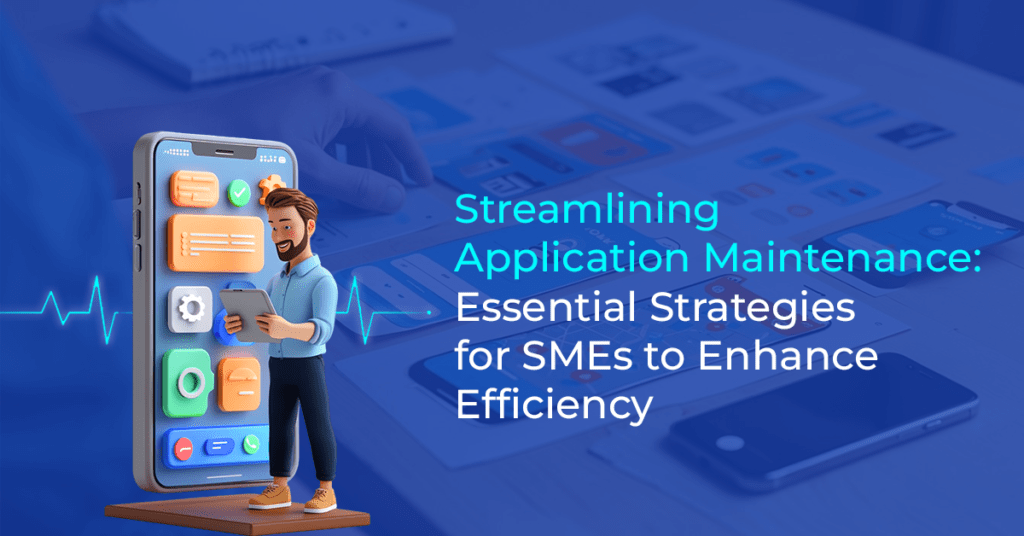Streamlining Application Maintenance: Essential Strategies for SMEs to Enhance Efficiency
Posted on : 28 October 2024 at 17:25 pm, by Puneet Aggarwal, Founder 7 dot 2 IT Consulting

Small and Medium Enterprises (SMEs) are the backbone of any economy, driving growth, innovation, and employment. However, in today’s extremely competitive digital world, SMEs need to focus on enhancing their operational efficiency to remain efficacious and profitable. One of the key areas that can significantly improve an SME’s productivity is efficient application maintenance. Properly managing and maintaining the applications that support daily operations is crucial for reducing downtime, improving performance, and ensuring seamless functionality.
In this blog, we’ll explore some essential strategies SMEs can adopt to streamline their application maintenance and enhance overall efficiency.
1. Automate Routine Maintenance Tasks
Automation is the cornerstone of efficiency in application maintenance. SMEs can leverage automation tools to schedule regular updates, monitor application health, and resolve common issues without human intervention. Automating routine tasks such as patching, backup, and performance monitoring can reduce manual workload and prevent human error.
a) Automated Monitoring Tools: These tools continuously check system performance and alert your team when issues arise.
b) Scheduled Updates: Ensuring that applications are always up to date with the latest patches, which helps maintain security and functionality.

2. Adopt Proactive Maintenance Practices
Instead of waiting for something to go wrong, proactive maintenance focuses on identifying and addressing potential issues before they cause significant disruptions. This approach can save SMEs from costly downtimes and keep their systems running smoothly.
a) Regular Health Checks: Conducting regular system audits and performance reviews to detect any underlying issues.
b) Performance Optimization: Continuously optimize your applications for better speed, resource management, and user experience.
3. Embrace Cloud-Based Solutions
Cloud technology is transforming the way businesses handle application maintenance. Cloud-based solutions offer SMEs the flexibility to scale their operations, reduce costs, and enhance efficiency.
a) Scalability: Cloud solutions can easily adjust to growing business needs without the need for expensive hardware.
b) Remote Access and Maintenance: Cloud platforms allow application maintenance to be done remotely, making it easier to manage and maintain applications from anywhere.

4. Outsource Specialized Maintenance Tasks
Not all SMEs have the in-house expertise required for complex application maintenance and other tasks outside their niche. In that case, outsourcing specialized tasks to third-party service providers can be a cost-effective way to ensure that your applications are maintained by experts without overburdening your internal team.
a) Benefits of Outsourcing: SMEs can focus on core business activities while external experts handle maintenance.
b) Third-Party Expertise: Outsourced teams often bring specialized skills and tools that can improve application performance and reduce risks.
5. Centralized Application Management
Centralizing the management of all applications allows SMEs to streamline their maintenance processes. By having a unified platform to monitor, update, and manage applications, businesses can eliminate redundancy and enhance coordination across teams.
a) Unified Dashboards: A single platform for monitoring the status of all applications ensures better visibility and quicker decision-making.
b) Integrated Systems: Ensuring that all applications work seamlessly together can reduce compatibility issues and enhance operational efficiency.
6. Train Employees for Basic Maintenance
While outsourcing and automation are effective, it’s also crucial to equip your in-house team with basic application maintenance skills. A well-trained workforce can handle minor issues in real-time, reducing the need for external intervention.
a) Employee Training Programs: Offering regular training sessions for employees to understand basic troubleshooting and application maintenance techniques.
b) Cross-Departmental Knowledge Sharing: Encouraging collaboration between IT and non-IT teams can help in identifying and addressing application issues early.

7. Regular Data Backup and Recovery Planning
Data loss can be catastrophic for SMEs. Establishing a reliable data backup and recovery plan ensures that your business can quickly bounce back in case of application failure or data corruption.
a) Automated Backups: Setting up automated, regular backups to protect your data.
b) Disaster Recovery Plan: Having a well-documented recovery plan ensures that your applications can be restored quickly in case of failure.
8. Continuous Performance Reviews
Finally, conducting ongoing performance reviews is essential to improving the efficiency of your application maintenance strategy. By analysing system performance regularly, SMEs can identify bottlenecks and areas for improvement.
a) Performance Metrics Tracking: Use KPIs like uptime, response time, and resource utilization to evaluate application performance.
b) Feedback Loop: Incorporating feedback from employees and customers to make necessary improvements in the applications.
Conclusion
For SMEs, efficient application maintenance is not just about keeping systems running but about driving growth, improving productivity, and ensuring the longevity of their business. By adopting the essential strategies discussed in this blog, from automation to cloud-based solutions, SMEs can streamline their application maintenance processes, enhance operational efficiency, and stay competitive in today’s dynamic marketplace.
